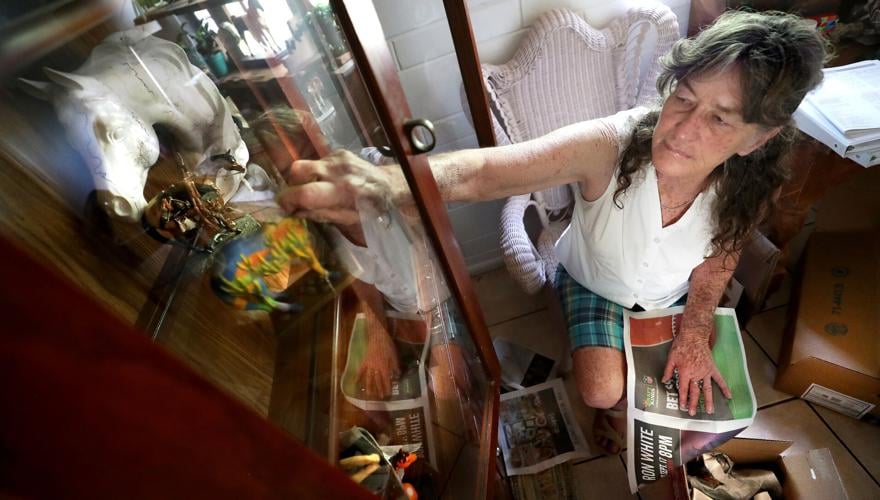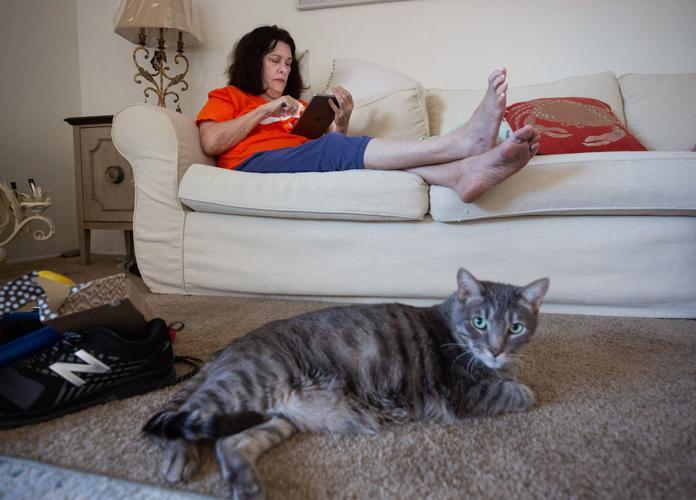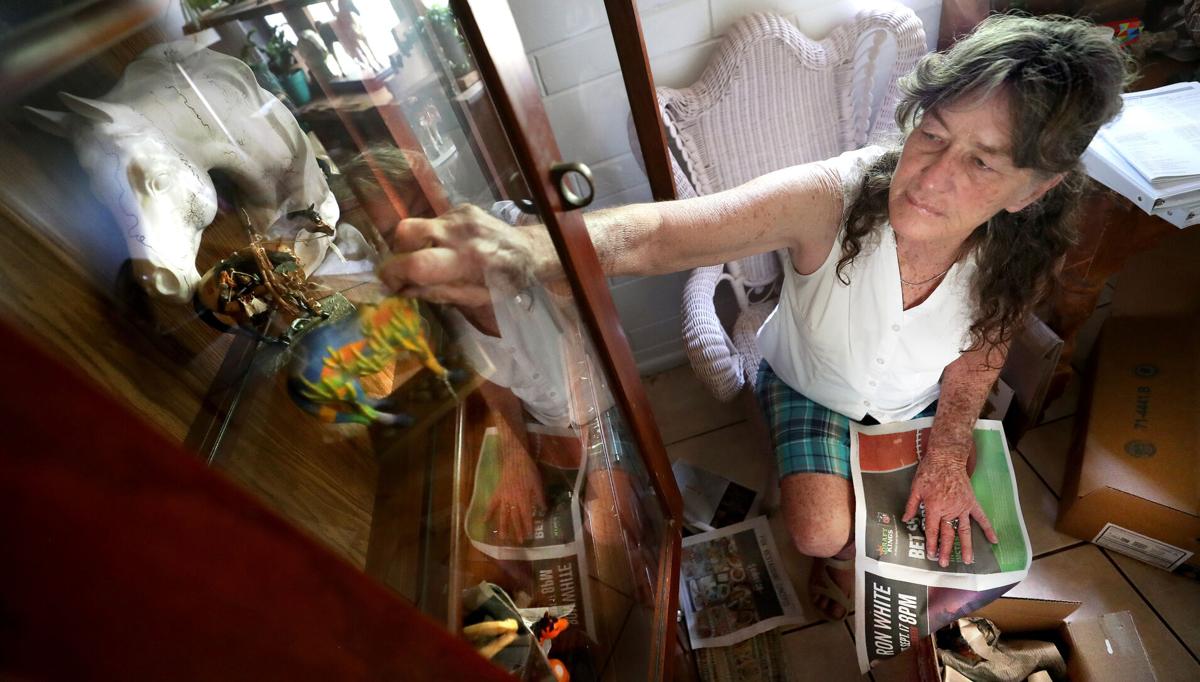Kathleen McClelland can’t afford the apartment where she’s lived the last 24 of her 76 years.
Rebecca Bishara, 69, never imagined working full time at this stage of life.
And when Kathryn Salinger learned, in August, that her rent would increase 40% by October, she began researching options. It’s been over a month and Salinger, 73, was still finalizing her plan last week.
These three seniors are among thousands in Pima County facing housing and financial instability, eviction filings, and even homelessness. People 65 and older are among the hardest hit by increased rental costs, but there is little data on how they are faring.
Requests for help, however, is one way to gauge.
Sister Jose Women’s Shelter has taken in four women over age 70 in the last couple weeks, and had to turn away a fifth because the shelter is at capacity. They are seeing a marked increase in elderly women becoming homeless for the first time, said Nicola Hartmann, chief operations officer for the shelter.
In the early 1990s, only 11% of the adult homeless population in Arizona was aged 50 and over. By 2003, the homeless senior population increased to 37%, and during state fiscal year 2021, according to the Arizona Department of Economic Security, people 55 and older were the largest age group to receive homeless services in the state.
Locally, the Pima Council on Aging saw a 30% increase in calls for housing help from January through late September this year compared to the same time period last year, said Victor Quiros, vice president of operations for the agency.
They are hearing from a growing number of older adults, especially women, who are being priced out of rental housing they’ve lived in for years, said Mark Clark, CEO of PCOA. He said these problems have been increasing for the last 18 months or so, with people — ranging from their late 60s to their early 80s — seeking help.
And Interfaith Community Services has helped at least 20 seniors facing housing problems and eviction risk in the last three months, including men, women and even couples. The nonprofit had $75,000 to spend on these seniors, and that money will be used up by the end of the month.
ICS recently received $100,000 from Tucson Councilman Steve Kozachik’s Ward Six funds to help elderly residents living there.
‘A very scary time’
Garleah Spicer, 67, lives in a rental that costs $800 per month — a price she could just afford — but when her lease expired a month ago, her landlord told her she needed to move.
Spicer, who is raising her grandson, was so desperate for help she began making phone calls at 8 a.m. and, on some days, continued that until dinner. She filled two notebooks with numbers and notes before she finally got some help, through Interfaith Community Services.
With that help, she has now secured a one-bedroom apartment. Spicer’s monthly income is about $1,200, she said, and that will rise to about $1,800 after she officially adopts her grandson at the end of October.
“I’m on a fixed income and Social Security, and as far as places I could afford to rent, there’s nothing,” she said. “It’s been a very scary time.”
Seniors are uniquely vulnerable to housing problems for reasons that include stagnant incomes, the inability, or limited ability, to work, the loss of a partner, and unexpected medical bills. Mobility challenges, social isolation, and memory problems can compound these challenges.
“This cohort is under-represented in most conversations about housing,” said Elizabeth Cozzi, associate vice-president of community development for the United Way of Tucson and Southern Arizona. “Older adults have specific needs that don’t always get addressed when we’re talking about housing stock.”
A recent two-year study by the United Way’s ELDER Alliance, along with the American Association of Retired Persons, and Tucson Housing Foundation, looks at ways to improve the availability of housing for older adults, Cozzi said, and to draw attention to the problem overall.
The group’s mission is to develop an affordable housing initiative that prioritizes the needs of the community’s most vulnerable members – lower-income older adults – and figure out how to help them get in housing they can afford near things they need: medical clinics, transportation, and grocery stores.
‘I consider this my home’
The United Way study’s many recommendations include creating incentives for building owners to retain affordable units for Section 8 residents, even as buildings are bought and sold, to provide more affordable housing overall, and to advocate on a local, state and national level for limits on landlord rent increases.
Kathleen McClelland knows the stress of rental increases. She moved here from California 24 years ago, a change she made to care for an aging relative.
On Monday, McClelland plans to sign her lease for another year in the apartment she’s lived in for over two decades. She will now be paying $900 per month in rent and $100 for utilities, a sizable jump from $707 in rent and $50 for utilities.
Like many seniors, McClelland has health problems that require attention, and money. She gets an epidural every 10 weeks to deal with back pain from a car accident, and that costs her $250 each time.
“I like where I live and I don’t want to move, but they keep raising the rent,” she said. “I consider this my home.”
McClelland is getting help from ICS for the next year. After that, however, she’s not sure exactly what’s going to happen.
Spencer Potrie works for the county’s Emergency Eviction Legal Services program, and has also been completing an internship with ICS as part of his master’s program in social work. He’s been focused on helping people 60 and older — people like McClelland.
‘I got terribly behind’
The longest time ICS can help someone is 12 months, Potrie said. The organization also tries to link people to other services such as food boxes, mobile meals and transportation options.
From late January through July this year, the county’s transitional housing operation served 176 people and 13 were over age 62, 10 females and three males.
The county’s data also shows that of the 699 tenants who sought help through the eviction legal services program since June 1, 41 of them, or about 6%, were age 65 or over. And the county’s rent and utility assistance system, from February 2020 to now, shows that roughly 8% of applicants have been over 60.
However, this covers only those applicants who have been assigned to a caseworker, and not anyone on the waitlist who has not been assigned one yet, said Andy Flagg, deputy director of the county’s Community & Workforce Development program and manager of Emergency Eviction Legal Services.
“Because applicants are not asked to enter a (date of birth) when they submit their inquiry online,” Flagg said, “the system does not track users by age, so we can’t tell you what portion of those on the waitlist are seniors.”
Potrie said ICS tries to focus on seniors who have not been able to get rental assistance elsewhere, such as through Pima County and its rent and utility assistance program. There’s about $7 million left in that account right, with a reallocation of $15 million pending.
“Some have definitely been in tight spots,” he said. “In some cases, we’ve rehoused some people who have been in unlivable situations.”
Some have eviction judgments against them, and limited time to find a new place to live.
Rebecca Bishara moved to Oro Valley from the Washington, D.C., area about seven years ago because the climate here is better for her health.

Rebecca Bishara’s cats keep her company while she works for an insurance company from her apartment in Oro Valley.
The move here was also a chance to try a new job, working with foster children through GAP Ministries. Things were going well until the pandemic hit and her hours were drastically reduced. Bishara said she could no longer rely on that job as her sole income.
For about two years, she looked for work and tried to get back into her previous field, which was insurance.
“I got terribly behind,” said Bishara, 69, who has a bad back due to the narrowing of her spinal canal and scoliosis.
“There were a lot of jobs I couldn’t do because of that,” she said of her medical challenges. A couple of weeks ago she started doing audits from home on her computer, nearly a full-time job.
She also has an eviction judgment against her now, however, and needs to move by the end of the year.
‘More seniors that need our help’
In two Census Household Pulse Survey waves, March 30 to April 11, and April 27 to May 9, the proportion of Arizonans not current on rent stayed the same, at 5.2%. However, in the most recent wave, from June 29 to July 11, that rose to 13.3%.
That’s according to a report by Keith Bentele, an associate research professor with the University of Arizona. Bentele’s August 2022 report “Housing Insecurity Indicators & Potential Homelessness Estimates for Arizona and Pima County,” shows rents are continuing to rise in Tucson, about 31% to 41% over the past two years.
People of racial and ethnic minority communities have increasingly found it difficult to stay current on rental payments, Bentele’s report shows, and are “experiencing difficulty meeting spending needs.”
People who find it difficult or impossible to walk, see, hear or concentrate well are disproportionately likely to report being behind on rent payments.
Kathryn Salinger’s initial setback happened 12 years ago, when she fell at Edwards Air Force Base in California and severely injured her spine. She continued to work as a financial analyst as much as she could until she medically retired a few years later.
She’s had 13 surgeries since that fall. Nowadays, she cannot walk more than a few steps because her spine is deteriorating, and the pain is excruciating. The injury also brought on osteoporosis and scoliosis.
She moved to Tucson from California in 2019 because she needed somewhere affordable to live, but Tucson no longer feels affordable.
Salinger’s rent was $1,000 when she moved in three years ago, but it’s now $1,500 per month. She’s been able get help with some of her expenses through Pima County and ICS and, since she has to move, is focused on getting to a new rental home near a spine institute in Colorado.
“I’m just trying anything and everything,” she said. “Will I be on the street? I cannot tell you that right now.”






